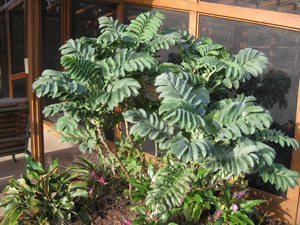Resource Library
Plant of the Week: Honeybush
The University of Arkansas System Division of Agriculture does not promote, support or recommend plants featured in "Plant of the Week." Please consult your local Extension office for plants suitable for your region.
Plant of the Week
Honeybush
Latin: Melianthus

To borrow a line from James Carville, it’s about the foliage, stupid.
Maybe it’s a guy thing but I find myself more attracted to the foliage effect of plants in the garden and don’t worry so much about flowers. To my wife this is heresy, but flowers are often fleeting or take a lot of tender loving care to keep them coming. Foliage, especially big bold plants such as Honey Bush (Melianthus major), get more dramatic as the season progresses and they make all the plants around them look better too.
Melianthus is a genus of six species from South Africa which belongs to its own family that contains a total of three or five genera, depending on how the counting is done. It is an evergreen shrub growing 6 (8 to 12) feet tall with 16-inch long pinnately compound, saw-tooth margined leaves. The leaflets are to 4 inches long, bluish - gray in color and give off a scent of peanut butter when crushed. Stipules grow together at the base of the petiole.
The plant form reminds me of leatherleaf mahonia (Mahonia bealei), but with softer, non-threatening leaves.
In late winter, plants produce an erect but nodding at the tip, terminal truss of maroon flowers that is held above the foliage. Though the flowers are said to smell of honey as the Latin name implies, the scent is faint. The flowers are only produced when the plant is protected inside or in areas where the wintertime temperature does not drop below 25 degrees Fahrenheit.
Melianthus, like so many garden plants, is a roadside weed in South Africa where it occupies a niche similar to what sumac does along Arkansas roadways. It is tough, drought-tolerant and a bit gangly if allowed to grow naturally.
This plant has been known to the garden world for several hundred years but it was primarily relegated to tropical climes or to large greenhouse collections. However, with the container plant revival over the past two decades, there has been an increased demand for large, bold-leafed plants. Melianthus fits the bill nicely. In containers it has most of its foliage topside while the bare stems at the base make room for other sturdy plants. If grown as a container plant, don’t be in a rush to repot it as it tolerates being root-bound quite well. Container plants can be cut back hard in the fall and the plant stored in a cool garage or sunroom until spring.
Melianthus is top-hardy to only about 25 degrees Fahrenheit but, according to plant guru Dan Hinkley it is root-hardy to 5 degrees Fahrenheit, making it a zone 7 plant. I have not seen the plant overwinter in Arkansas but a sheltered location on the south side of a building and a thick layer of mulch should provide sufficient protection for most winters in all parts of the state. When grown in this way it becomes a perennial not a shrub so space it so the top has room to develop. No flowers will form as the plants bloom on year-old wood.
Propagation is by seed or cuttings taken during the growing season. The foliage is poisonous if ingested but livestock, and even deer, won’t eat it because of the noxious taste. In its native land the foliage is used in medical concoctions.
By: Gerald Klingaman, retired
Retired Extension Horticulturist - Ornamentals
Extension News - October 26, 2012
The University of Arkansas System Division of Agriculture does not maintain lists of retail outlets where these plants can be purchased. Please check your local nursery or other retail outlets to ask about the availability of these plants for your growing area.